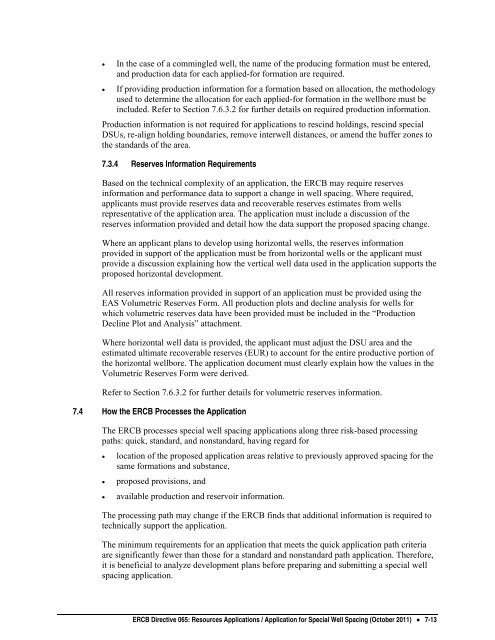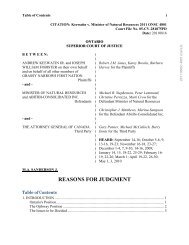Directive 065: Resources Applications for Oil and Gas Reservoirs ...
Directive 065: Resources Applications for Oil and Gas Reservoirs ...
Directive 065: Resources Applications for Oil and Gas Reservoirs ...
You also want an ePaper? Increase the reach of your titles
YUMPU automatically turns print PDFs into web optimized ePapers that Google loves.
• In the case of a commingled well, the name of the producing <strong>for</strong>mation must be entered,<br />
<strong>and</strong> production data <strong>for</strong> each applied-<strong>for</strong> <strong>for</strong>mation are required.<br />
• If providing production in<strong>for</strong>mation <strong>for</strong> a <strong>for</strong>mation based on allocation, the methodology<br />
used to determine the allocation <strong>for</strong> each applied-<strong>for</strong> <strong>for</strong>mation in the wellbore must be<br />
included. Refer to Section 7.6.3.2 <strong>for</strong> further details on required production in<strong>for</strong>mation.<br />
Production in<strong>for</strong>mation is not required <strong>for</strong> applications to rescind holdings, rescind special<br />
DSUs, re-align holding boundaries, remove interwell distances, or amend the buffer zones to<br />
the st<strong>and</strong>ards of the area.<br />
7.3.4 Reserves In<strong>for</strong>mation Requirements<br />
Based on the technical complexity of an application, the ERCB may require reserves<br />
in<strong>for</strong>mation <strong>and</strong> per<strong>for</strong>mance data to support a change in well spacing. Where required,<br />
applicants must provide reserves data <strong>and</strong> recoverable reserves estimates from wells<br />
representative of the application area. The application must include a discussion of the<br />
reserves in<strong>for</strong>mation provided <strong>and</strong> detail how the data support the proposed spacing change.<br />
Where an applicant plans to develop using horizontal wells, the reserves in<strong>for</strong>mation<br />
provided in support of the application must be from horizontal wells or the applicant must<br />
provide a discussion explaining how the vertical well data used in the application supports the<br />
proposed horizontal development.<br />
All reserves in<strong>for</strong>mation provided in support of an application must be provided using the<br />
EAS Volumetric Reserves Form. All production plots <strong>and</strong> decline analysis <strong>for</strong> wells <strong>for</strong><br />
which volumetric reserves data have been provided must be included in the “Production<br />
Decline Plot <strong>and</strong> Analysis” attachment.<br />
Where horizontal well data is provided, the applicant must adjust the DSU area <strong>and</strong> the<br />
estimated ultimate recoverable reserves (EUR) to account <strong>for</strong> the entire productive portion of<br />
the horizontal wellbore. The application document must clearly explain how the values in the<br />
Volumetric Reserves Form were derived.<br />
Refer to Section 7.6.3.2 <strong>for</strong> further details <strong>for</strong> volumetric reserves in<strong>for</strong>mation.<br />
7.4 How the ERCB Processes the Application<br />
The ERCB processes special well spacing applications along three risk-based processing<br />
paths: quick, st<strong>and</strong>ard, <strong>and</strong> nonst<strong>and</strong>ard, having regard <strong>for</strong><br />
• location of the proposed application areas relative to previously approved spacing <strong>for</strong> the<br />
same <strong>for</strong>mations <strong>and</strong> substance,<br />
• proposed provisions, <strong>and</strong><br />
• available production <strong>and</strong> reservoir in<strong>for</strong>mation.<br />
The processing path may change if the ERCB finds that additional in<strong>for</strong>mation is required to<br />
technically support the application.<br />
The minimum requirements <strong>for</strong> an application that meets the quick application path criteria<br />
are significantly fewer than those <strong>for</strong> a st<strong>and</strong>ard <strong>and</strong> nonst<strong>and</strong>ard path application. There<strong>for</strong>e,<br />
it is beneficial to analyze development plans be<strong>for</strong>e preparing <strong>and</strong> submitting a special well<br />
spacing application.<br />
ERCB <strong>Directive</strong> <strong>065</strong>: <strong>Resources</strong> <strong>Applications</strong> / Application <strong>for</strong> Special Well Spacing (October 2011) • 7-13
















